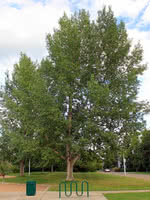Mon-Fri 9am - 5pm Mountain time
Assiniboine Poplar vs Black Cherry
Populus x Assiniboine
Prunus serotina
NOT AVAILABLE THIS SEASON - MIGHT RETURN
Assiniboine poplar is a tall, fast growing tree that has a shapely oval form and dense foliage. This hybrid poplar is a male clone and produces no fuzz or fluff. Assiniboine poplar can handle tough conditions such as: urban pollution, environmental salt, drought, poor soil, and even some standing water.
Black Cherry is common in eastern North America but a rare find elsewhere. This tree is shade tolerant and is often found in old fields, forest openings, and along fencerows.
The fruit is edible and is commonly used to flavor rum and brandy. It is also edible and often eaten fresh or used in wine or jelly. Black Cherry trees typically begin producing fruit when they are 10 years of age.
Black Cherry wood is a rich reddish-brown color and is strong, making it valued in cabinetry and woodworking. It is often used in reclamation as well.
The leaves can poison livestock as they contain cyanide derivatives and precursors. However, many have noted that deer still seem to browse their trees with impunity and birds and other animals eat the fruit when available.
Assiniboine Poplar Quick Facts
Black Cherry Quick Facts
Toxicity: bark and wilted leaves toxic to livestock
In row spacing: 2.4 - 3 m (8 - 10 ft)

